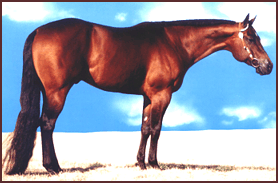
COMMON HORSE BREEDS
| QUARTER HORSE
Origin: |
 Photo supplied by Rutlands Quarter Horses - "A Passing Breeze Imp USA" - Victoria, Australia © |
History:
The Quarter Horse originated from horses taken to America by Spanish
conquistadores. During the 17th and 18th century English settlers on the East coast of
North America crossed their own imported horses with Spanish horses to produce a strong,
good natured horse for riding and farm work. Quarter Horses played a big part in the days
of cattle herding where a fearless, athletic and totally dependable horse was required.
These horses learned to predict the movement of a steer, stopping and turning at breakneck
speed.
To satisfy their passion for racing Englishmen raced their Quarter Horses anywhere where
they had enough room for a gallop. The breed developed extremely strong hindquarters
enabling them to go from a standing start straight into full gallop. As the name implies
the Quarter Horse excels at racing over a short distance - a quarter of a mile. Later
Thoroughbred racing became more popular.
In 1940 the American Quarter Horse Association was formed, which is now the largest
registry of any breed in the world with more than 2 million horses listed.
Characteristics:
| Head: short, wide head; large, intelligent eyes; small muzzle; alert, medium size ears Neck: flexible, fairly long Shoulders: sloping, well defined withers Body: compact body; strong, short back; broad chest; well sprung ribs; deep girth; powerful loins; long, gently sloped croup; broad, well muscled hindquarters Legs: good limbs; forelegs wide set; muscular thighs and gaskins; short cannons; medium length pasterns; strong, low set hocks, giving tremendous acceleration Color: any solid color Height: 14.3 to 16hh Temperament: renown for their gentle, pleasant nature Qualities: strong, fearless, athletic, fast over short distance |
|
Today:
Quarter Horses are popular in rodeos, barrel racing and horse racing over
short distances. They are also used as police mounts and in a wide variety of pleasure
activities.
![]()
